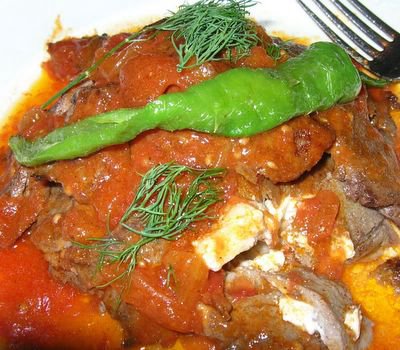
Clockwise from top left: Ti Jos; The crepe walnut and honey; A piece of art from the Pompidou; The Arc at night.
RESTAURANT: Ti Jos
LOCATION: Rue Delambre, 14e, Paris, France
DATE: September 9, 2005
FOOD: Split a Galette Champignons, Jambon, Fromage; Crepes Miel, Noux (Honey and Walnut)
DRINK: Tap Water
PRICE: 9.00 Euros
Ah, but what would Paris be without its food? Perhaps romantic, perhaps historic, but certainly less satisfying in a very immediate way. It’s the cuisine that puts us in France and the food that puts France in us. Without the patisseries and cafes, the baguettes and chocolate, Paris would be less than what it is and for this, we’d all suffer from the loss.
But, fortunately, the French culinary tradition is alive and well. And while nouveaux American cuisine has bogarted much from its European ally and cross-pollinated it with other world flavors like Mendel and his flowers, the taste of authenticity and un-tampered with classic French cuisine still can defrost even the worst of transatlantic tensions. What food better exemplifies French cooking than the crepe? Ti Jos, a creperie and cider restaurant, excels at making traditions relevant. The crepes are created by a woman advanced in age but also in culinary skill, and who by all appearances, could very well pass for Whistler’s mother. The clientele are locals, a well-needed respite from the discordant American voices heard ubiquitously all over the city.
But the crepes, the crepes are the thing themselves. Street vendors may sell more common, inexpensive versions, but to sample the real deal, Ti Jos is the place. The menu is divided into galletes and crepes, the gallettes consisting of a buckwheat base and filled with savory items like beef, cheeses, and ham, whereas the crepes are all sweetness, all the time.
We began by splitting a ham, cheese, and mushroom galette, and while the ham was nowhere to be seen (Whistler’s mom has a lot on her mind), the galette was still densely rich and brilliantly smooth. The mild coat of gruyere cheese enhanced the smoky aspects of the sautéed, though still firm mushrooms. Nothing was overcooked and all blended together seamlessly in a galette, that though grain based was nonetheless effortlessly light.
For dessert, there was no splitting. My honey and walnut crepe was a commendable dessert, though it would have worked nicely for a petit dejeuner as well. The walnuts came whole, topping the honey glaze of the crepe. The honey was effectively sweet without being birthday cake saccharine. However, the crepe itself, slightly chewy, thoroughly moist and in all ways outstanding, proved why Ti Jos was a local favorite. Everything about the meal was successful (save the forgotten ham) and the next time Bush and Chirac clash over the former’s refusal to recognize global warming or the lack of WMD, perhaps a plate of Ti Jos’ crepes, Whistler’s mother included, will serve to reach the cowboy in a place reason can not.
RATING: 8.2/10










